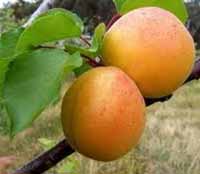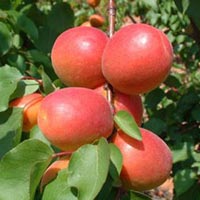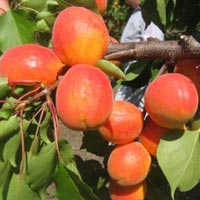APRICOT SEEDLINGS or
APRICOTE FRUIT TREE PLANT
Apricot seedlings in Gajić Nursery!
Apricot (lat. Prunus armeniaca, tur. kayısı) is a continental bony fruit that, along with plums, almonds, peaches and cherries, belongs to the Prunus genus of the Rosaceae family.
The center of origin and the natural area of this species is difficult to define, due to early domestication (3rd millennium BC). Apricots are most likely to originate in Central Asia and Northeast China, from an area near the Russian border. It is possible that the species' natural habitat includes the Korean Peninsula and Japan. Apricot, though its botanical name suggests, does not originate in Armenia. In Armenia, apricots arrived after 3000 years, spreading along the Silk Road. From there the Romans, around 70 BC, spread it throughout Europe.
Today, wild (undomesticated) apricots grow in very small groups in China, Kazakhstan, Kyrgyzstan and Uzbekistan. Due to the small number of these populations, the species Prunus armeniaca is considered endangered.
Cultivated apricot varieties are widespread across the globe. It thrives best in areas with a mild, Mediterranean climate, resulting in intensive commercial cultivation in such areas.
Apricot grows as a shrub or small tree, 8-12 m high, with a trunk up to 40 cm in diameter. The crown shape is round, sometimes flat. The bark of the tree is dark gray, longitudinally cracked. Young branches and leaf stalks are often reddish in color. The leaves are oval, 5-10 cm long, 5-8 cm wide, with a pointed tip, a rounded base and a serrated edge. The leaf stalks are 2-4 cm long.
The flowers have a short flower stem, so they often have the appearance of sessile flowers. They develop individually or in pairs, usually before the leafing. The flower diameter is 2-4.5 cm.
The receptacle and calyx lobes are hairy, crown petals white to pale pink, 11-15 mm long. Apricot is a self-fertilizing, rarely cross-fertilized plant (auto-incompatible are, for example, 'Riland' and 'Perfection' cultivars). The most important pollinator is the bee.
The fruit is a bone, reminiscent of a small peach, 1.5-2.5 cm in diameter, yellow to orange, sometimes red on the sun-exposed side. There is one seed inside the hard bone. The diploid chromosome number is 2n = 16.
Seedlings of APRICOT - HUNGARIAN BEST:
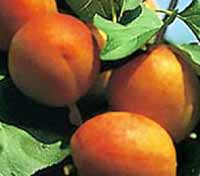 The Hungarian best yields a large fruit weighing 50g. It can be halved easily. It is red with characteristic spots.
The Hungarian best yields a large fruit weighing 50g. It can be halved easily. It is red with characteristic spots.
The fleshy part is orange in color, quite firm, juicy, sweet-sour and aromatic, very good quality.
It is self-fertile and quite resistant to low temperatures. The fruit is easily separated from the bone.
Ripening time: Mid-July
Rootstock: Cherry plum
Seedlings of APRICOT - NOVOSADSKA RODNA:
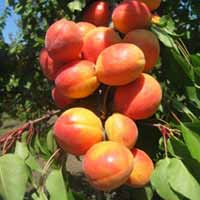 The Novosadska rodna seedlings are of domestic origin. Novosadska rodna has a fruit that is medium-sized, elongated-round in shape.
The Novosadska rodna seedlings are of domestic origin. Novosadska rodna has a fruit that is medium-sized, elongated-round in shape.
The epicarp is orange, red on the sunny side.
It is light orange in color and the fleshy part is orange, very tasty and aromatic.
It can be halved easily. The disadvantage is that the tips of the bone break. It is suitable for the production of brandy.
Ripening time: Mid-July
Rootstock: Cherry plum
Seedlings of APRICOT - ROXANA:
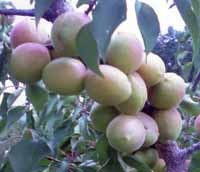 The Roxana seedlings yield a very large fruit, on average 70g, it can be halved easily, elongated, orange with intense redness. The fleshy part is firm, very tasty.
The Roxana seedlings yield a very large fruit, on average 70g, it can be halved easily, elongated, orange with intense redness. The fleshy part is firm, very tasty.
Attractive for the market, great for eating and processing. It blooms late.
Ripening time: End of July – Beginning of August
Rootstock: Cherry plum
Seedlings of APRICOT - KECSKEMET ROSE:
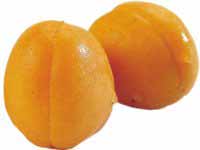 The Kecskemet Rose seedlings are originally from Hungary. The fruit is small to medium-sized, asymmetrical, round-flattened, light orange in color with red on the sunny side. Fruitfulness is high, when it becomes abundant, part of the fruit remains green.
The Kecskemet Rose seedlings are originally from Hungary. The fruit is small to medium-sized, asymmetrical, round-flattened, light orange in color with red on the sunny side. Fruitfulness is high, when it becomes abundant, part of the fruit remains green.
The fleshy part is orange-yellow, resistant, refreshing in taste and of pronounced aroma, transport resistant.
Ripening time: End of July
Rootstock: Cherry plum
Seedlings of APRICOT - NEW JERSEY:
The New Jersey seedlings are originally from the US. It has excellent fruitfulness and high quality fruit.
The fruit is large, round, the epicarp is yellowish-orange, the fleshy part is medium-firm and golden yellow, sweet-sour, very tasty and easily separated from the bone.
It must be harvested a little earlier when turning green to yellow, as the ripe fruit fall off a lot.
Ripening time: End of June – Beginning of July
Rootstock: Cherry plum
Seedlings of APRICOT - NS 4:
Sadnice kajsije NS 4 - Seedlings of NS - This variety was created through selection from a natural population. The fruit is large to very large, round in shape. The epicarp is orange, with red on the sunny side. The fleshy part is easily separated from the bone, it is juicy, sourish, refreshing, and its color is orange.
Ripening time: End of July
Rootstock: Cherry plum
Seedlings of APRICOT - NS 6:
Seedlings of NS 6 - This variety was created through selection from a natural population. The fruit is medium-sized to large, round, but slightly flattened on the side. The epicarp is light orange and has a pronounced redness on the sunny side. The fleshy part is easily separated from the bone, juicy, aromatic, firm and the color is light orange. It blooms late.
Ripening time: End of July
Rootstock: Cherry plum

